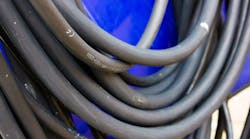The rules for protecting flexible cords [240.5] differ from those for protecting conductors [240.4]. You must protect a flexible cord in one of two ways.
The first way is you protect it with an overcurrent device based on its ampacity as specified in Table 400.5(A)(1) and Table 400.5(A)(2). That’s right, you’re also using Art. 400 for this. But if it’s fixture wire, use Table 402.5 (yep, Art. 402). You can use supplementary overcurrent protection, as covered in Sec. 240.10.
The other way, if the conductor’s supplied by a branch circuit, is you use one of the methods in Sec. 400.5(B)(1), (3), or (4). If it’s fixture wire, it must comply with the size requirements enumerated in Sec. 400.5(B)(2). So what are those three methods (if it’s not fixture wire)?
• 400.5(B)(1). Used with a specific listed appliance or luminaire, if approved for that use.
• 400.5(B)(3). Used in listed extension cord sets.
• 400.5(B)(4). Used with separately listed and installed components in field assembled extension cord sets, if 16AWG or larger for 20A circuits.



